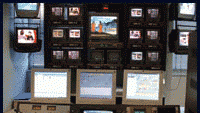RFO: Powered by SGT
RFO has long been one of the world’s most geographically developed television networks. Our channels broadcast programs in nine different time zones, covering a time span of 22 hours. In recent years, we have also become one of the most technologically developed broadcasters, having begun the conversion to digital more than five years ago. In order to complete this important transition, we decided to base our new system on the three product lines offered by SGT: Traffic Management, Transmission Management and Media Management. Our choice was guided by the list of objectives that we had defined.

The starting point for every program broadcast in the worldwide network of RFO begins with DBOS Media Manager for ingest and quality check.
Our first objective was to increase our number of broadcast channels from two to twelve. This would have been a virtually impossible task with an installation based on videotapes. The stock of tapes in Paris, which was already quite extensive, would have grown to unwieldy proportions due to the duplications needed for transmission — without counting the local stocks in each of our remote sites. Therefore, we decided to implement an entirely digital architecture, eliminating any use of tapes from the moment a program is entered into the system. In addition to saving space and the cost of discarded tapes, this decision offered us increased productivity, flexible operation and guaranteed adaptability. Taking this line of reasoning to its logical conclusion, we decided to consolidate the entire configuration with traffic software that would play the role of a unifying decision support system.
Only a few companies had the expertise and products we needed. After considering their offers, we decided to work with SGT. The veritable “backbone” of RFO’s new system is the Traffic Management function, which was installed at the beginning of the operation, both in Paris and at the remote sites. Its synchronization functions enable us to share information on our program bank in an entirely transparent way. Because 80 percent of our programs come from the French national channels, which are recorded in Paris, this flexibility allowed the remote sites’ programming departments to create their own scheduling grids with total independence.
The Pregrid and Program Grid modules make it possible to compile and manage these grids starting from three months before broadcast right up to 12 hours before they go on the air. The grids are then sent to the transmission cells, which send back the as-run logs the next day. Traffic Management analyzes the logs and updates the broadcast rights in the program bank.
The continuity rooms of RFO are powered by SGT’s DBOS Automation product, which manages nearly 40 channels 24-hours a day in Paris and in overseas territories.
In parallel, the installation of the automation systems of the Transmission Management line was accomplished in two phases: first at the Paris site, with its 12 channels, and then at the overseas sites. In Paris, videotapes are digitized upon acquisition, and the resulting files are stored on one of 10 MediaStream servers or in a StorageTek cart machine. (All of these devices are on a Fibre Channel loop.) At this point, DBOS Loader takes over. This powerful, cleverly designed technical software program handles all file movements within the system, from acquisition to broadcast. Depending on the content of the playlists coming from Traffic Management, it automatically chooses and schedules the transfers that need to be carried out (between servers or from the archiving cart machine). Thanks to this optimized functioning, we have achieved bandwidth gains of about 30 percent.
The professional video industry's #1 source for news, trends and product and tech information. Sign up below.
For the final transmission, we decided to standardize all the automated channels. Each DBOS automation unit of the 12 in the system can take over any channel and control all of its equipment. This gives us a much more flexible organization, especially when installing new channels or when a channel is down for maintenance. In addition, using the set of remote controls integrated into the software, a single operator can remotely activate all the DBOS automation units with a simple click of the mouse.
At our remote overseas sites, the automated system handles the broadcasting of three channels, including one that is reserved for transmitting locally produced programs to other sites. These video transfers between the various sites use a principle similar to video over IP, which enables the automatic identification of the programs being sent.
The final aspect of the automation system concerns post-production. SGT’s Media Manager program han- dles this function, in particular in Guyana, which was the first site to be equipped. The modularity of this product has allowed us to carry out a gradual implementation, for example starting with the Acquisition, Content Checking and Browsing modules. Other modules, such as Offline Editing, can be put into service later without interrupting the users’ work routines.
All of the products we have installed have one important advantage in common: They enable fast and preventive supervision. When functional anomalies occur in operation, they are often preceded by certain indicators (reduced network bandwidth, read errors on the cart machine, etc.). These indicators appear in the SGT products’ alarm messages and are acted upon by users whom we have trained in a new supervisor job function. This gives us much more security in our day-to-day operations.
We knew from the start that the vast functional coverage offered by SGT’s products would be one of the cornerstones for the success of our project, and we were proven right. We have installed an innovative architecture that is several years ahead of the market, and our choice has been corroborated by the granting of several IBC Awards three years in a row.
Christian Augereau is technical director of RFO.
